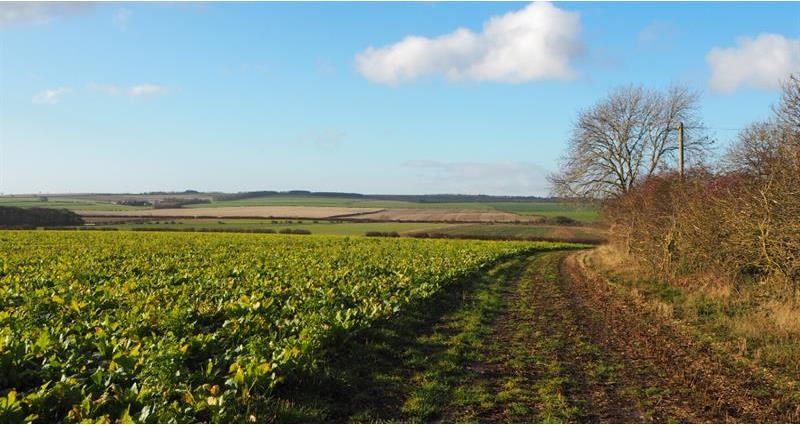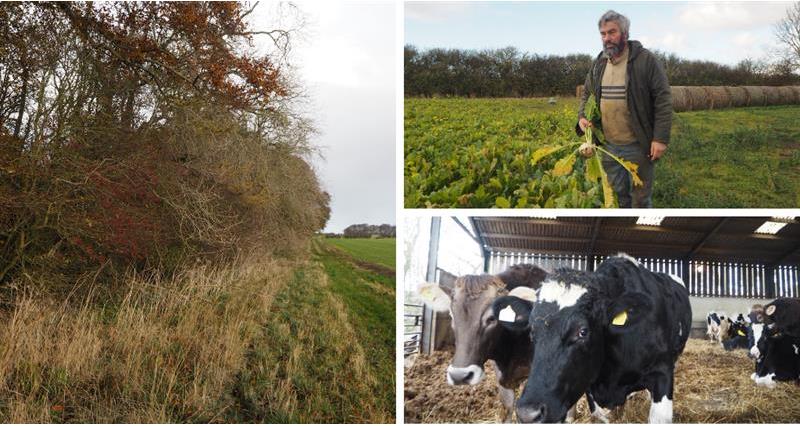The Gatenby family have farmed at Littlethorpe for the last 100 years and John is the fourth generation. John’s wife, Chris, helps to run the farm office, and their adult daughter, Rosie, helps out on the farm during busy periods. The farm is just over 500 acres, including 600 cattle.
Arable Rotation
John grows winter wheat and barley for seed, potatoes, carrots and vining peas. John also grows cover crops including stubble turnips, mustard and rye and these are grazed by another farmer’s sheep. Some of the maize goes to a local anaerobic digestion plant.
John’s arable rotation follows a pattern of two years of barley or wheat seed, a one year break, two years seed again, and another one year break. Three fields that are well fenced and suitable for grazing have a three-year ley and then are brought back into the rotation.
The farm has previously experimented with growing nettles as a crop in collaboration with De Montfort University. John is forward-thinking and keen to invest in the future of the farm, emphasising that voluntary, site specific targeted measures like this are the key to future success.

Soil
The soil type is mainly typical Yorkshire Wolds soil – very shallow over chalk and gravel but around 15% to 20% of the soil is not sandy or shallow. John also fattens Holstein cattle with 600 cattle on farm at present. The cattle are fed a mix of forage maize, peas and by-products from the food industry, called 'bio-recycling', including haribo from the confectionery industry.
John utilises the muck that the cattle produce to build up the organic matter in the soil. Using the muck also reduces the need for phosphate fertilisers and potash. John does not use advisers or agronomists but he is BASIS and FACTS registered, and works closely with local advisers from other organisations such as RSPB and GWCT on agri-environmental initiatives.
During John’s time running the farm he has focused on investing in the farm infrastructure, land and irrigation systems for the potatoes and carrots. Using the cattle manure John has been able to improve the organic matter content of the otherwise shallow, sandy soil - as a result the soil quality has improved and means fields that previously were too sandy to hold a crop in the windy climate are productive. This also helps to mitigate the challenges posed by the rainfall in the area, which is an average of 21 inches on shallow soil.
By using a heavier, reversible plough John is able to work the chalky soil, creating over nine inches of workable soil which can be worked earlier after rainfall. The soil can also be worked earlier, which helps to increase the nutrient holding soil matter, which keeps the crops healthy during the summer.
John highlights that other farmers in the area are beginning to realise the importance of muck and he has managed to set up several muck for straw arrangements. John regularly welcomes agronomists and visitors to look around the farm and monitors and benchmarks the farm worm count in partnership with Rothamsted research centre. Current worm count figures exceed the desired 400 worms/m2, almost reaching 1000 worms/ m2.
John uses a smaller, lighter tractor with floatation tyres fitted to reduce soil compaction. John feels that his investment in the soil has paid off with better crop health, particularly during times of stress due to the weather, and high carrot yields of 74t/ac.

Environmental Schemes
John was previously in an entry level stewardship scheme (ELS) but found that the replacement scheme was not user friendly. John now continues to follow much of the management practises on voluntary basis but states that this does come at a financial cost. John is able to carry out environmentally beneficial practices on a voluntary basis alongside running a productive farm.
The farm has close links with the local RSPB adviser and has hosted GWCT farm walks. Four farmland bird surveys have shown an increase in numbers each time, particularly of oyster catchers who like the damp, irrigated land. The use of cover crops, such as stubble turnips and mustard, also provides bird feed through winter.
John states that he has seen a noticeable move towards contract farming in surrounding area, with around 60% of the land in the area under contract management.

The future
In the future John wishes to see a greater awareness of soil health, which he believes goes in conjunction with more mixed farming and adjusting the machinery to reduce the impact on soil.
John also believes that when contract farming, activities should be carried out at the right time of year and in a way which suits the unpredictability of the weather and the markets.
In terms of policy, John would like to see greater support for productivity investments, such as a building allowance. Equally, he would like to see a change in public perception, which recognises the good work that farmers do. This will require farmers to engage further with the general public and opposition groups to showcase the environmental benefits that farmers are producing and enhancing. John firmly believes that farming is something you must enjoy and this message must be celebrated.
